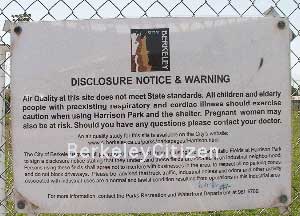
Seeking
Big Picture on
Oceanview Air Emissions
Seeking Big Picture on Oceanview Air Emissions
More than three decades have come and gone since the first voices were raised over the redevelopment of West Berkeley and its health impact on Oceanview residents. These community voices have been kept alive by the continued challenge of economic development to create sustainable growth and maintain an acceptable level of environmental quality for residents. The recent reports regarding West Berkeley's lowered life expectancy, greater incidence of hospitalizations for asthma, and the compelling public testimonials on health problems have begun to fuel an environmental reawakening in this sector of the flatlands.
The Oceanview district, if you follow your nose, is bordered by Interstate 80 and dotted with a wide range of manufacturing businesses. This area is also recognized as having Berkeley's poorest air quality. Residents have long suspected that their health is being compromised and have repeatedly asked the city to quantify Oceanview's odorous air quality. That has yet to be accomplished.
Historically, you will find that actual air monitoring is as rare as chicken's teeth. The high cost of sampling air emissions and the lack of political will have stifled any substantive investigations.
However, last year, council took the initial steps in acknowledging Berkeley's air quality quandary by requesting that the Bay Area Air Quality Management District (BAAQMD) conduct a cumulative emissions study. Due in April, the study of BAAQMD discharge permit holders located within a quarter mile of Second and Gilman streets is, in effect, a first call for regional air regulators to develop the big picture of air emissions in Oceanview.
Perhaps in response to the BAAQMD current scoping effort or because of its severe limitations, Oceanview District Representative Linda Maio has proposed another West Berkeley air monitoring study. This plan is small in scope, and appears to turn away from the industrial stacks, and instead focuses on freeway emissions. Maio's plan, which calls for air sampling at three locations, two of which are to straddle the freeway, virtually dismisses the industrial factor.
For years, citizen complaints have centered on odors and toxic chemicals discharged by local manufacturing enterprises, and not freeway emissions. It's no wonder that the proposed monitoring budget of $10,000 and its sampling scheme are being called extremely shortsighted.
It should be noted that in 1997, a two-day air study, was managed by the city's Toxic's Management Division concerning the proposed Harrison Street playing fields. This monitoring effort, which TMD staff publicly admitted was inadequate, cost two and a half times the amount requested by Councilwoman Maio.
Moreover, the antiquated BAAQMD monitoring equipment offered for the new Maio study is called a nephelometer. It is limited to measuring the overall haziness of the air sampled, and hence is only an indirect measurement of particulates, the obvious focus of Maio's plan. Furthermore, the spot use of the nephelometer will also restrict its effectiveness of collecting any usable data. Most importantly, this new study does not include any analysis of airborne chemicals.
Maio's plan should be expanded and refocused to include the Gilman Street corridor. A possible Gilman corridor monitoring plan could set a scope of work to include a series of at least seven monitors stretching along Gilman Street, downwind from industry and the freeway. Two could be placed as described by Maio's plan and three more monitors beginning at 7th Street, which is in the heart of the manufacturing district. Finally, the last two monitors would be placed at Berkeley High School and in the hill area.
This study would consist of a yearlong protocol of 35 samplings at each station, or all at once every 12 days. Sampling would be conducted for both particulates and chemical analysis.
A Gilman Corridor plan, which would probably cost about $300,000, is obviously more than requested by Maio, However, unlike Maio's plan, this larger scope be a better investment of public money because the city would actually create a real baseline for evaluating Oceanview air quality, both of particulates and toxic chemicals.
Now is the time to answer these long-standing questions regarding freeway and industrial emissions which continue to plague west Berkeley residents. This is an opportunity Berkeley can not afford to miss.
"Seeking Big Picture on Oceanview Air Emissions" by L A Wood
Published: February 11, 2000 Berkeley Voice
Berkeley Citizen © 2003
All Rights Reserved
All Rights Reserved
